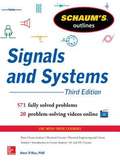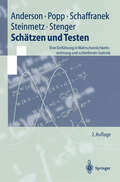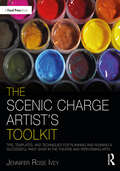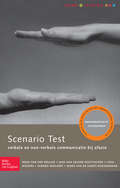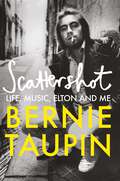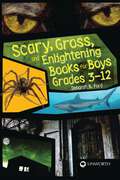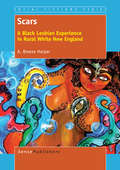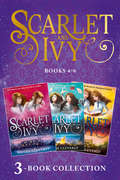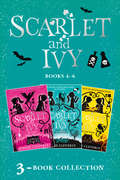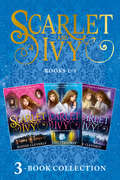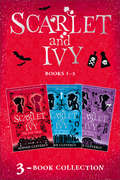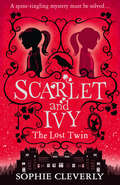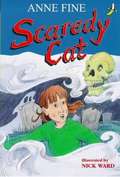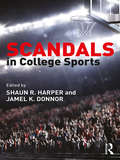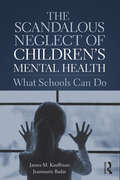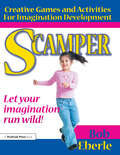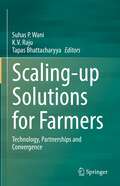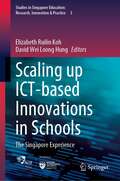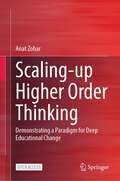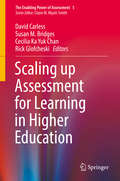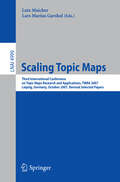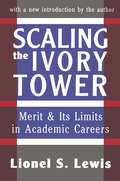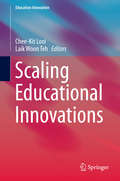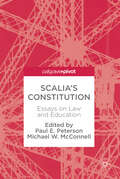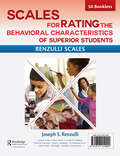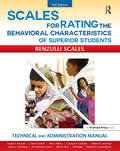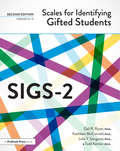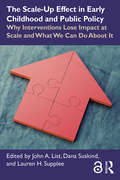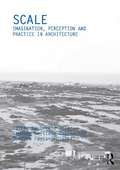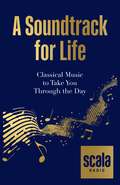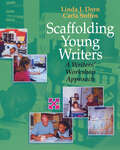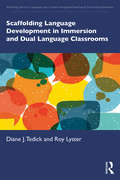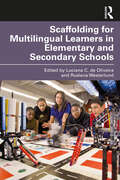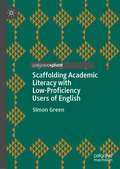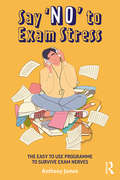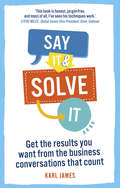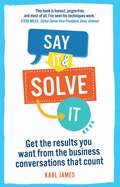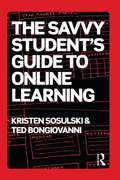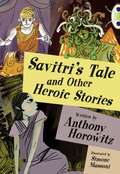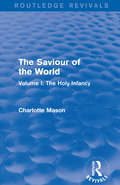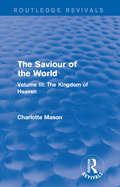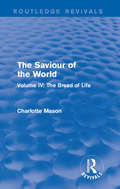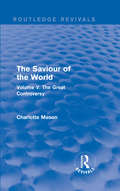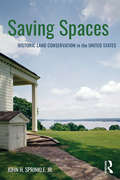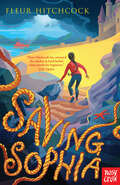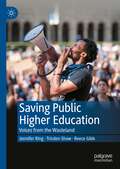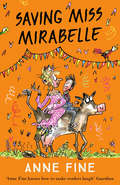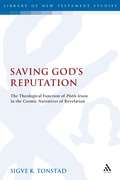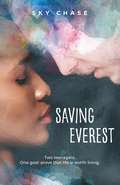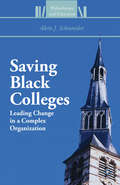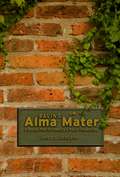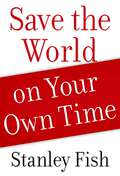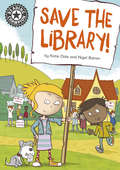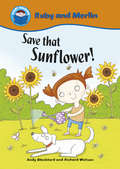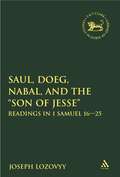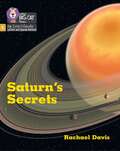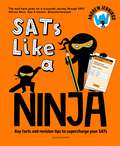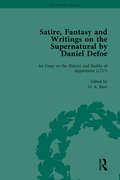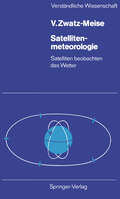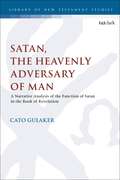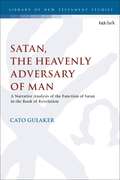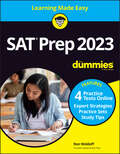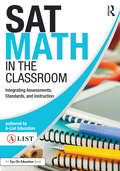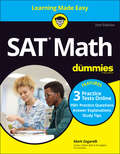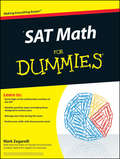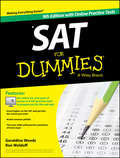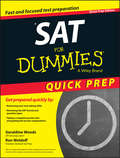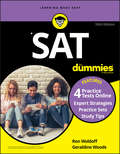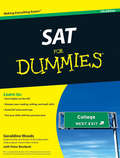- Table View
- List View
Schaum s Outline of Signals and Systems 3ed. - Schaum's Outline Series (PDF)
by Hsu Hwei PTough Test Questions? Missed Lectures? Not Enough Time? Fortunately, there's Schaum's. More than 40 million students have trusted Schaum's to help them succeed in the classroom and on exams. Schaum's is the key to faster learning and higher grades in every subject. Each Outline presents all the essential course information in an easy-to-follow, topic-by-topic format. You also get hundreds of examples, solved problems, and practice exercises to test your skills. This Schaum's Outline gives you 571 fully solved problems Bonus material on matrix theory and complex numbers Support for all the major textbooks for signals and systems courses Fully compatible with your classroom text, Schaum's highlights all the important facts you need to know. Use Schaums to shorten your study time--and get your best test scores! Schaum's Outlines--Problem Solved.
Schätzen und Testen: Eine Einführung in Wahrscheinlichkeitsrechnung und schließende Statistik (Springer-Lehrbuch)
by Oskar Anderson Werner Popp Manfred Schaffranek Dieter Steinmetz Horst StengerStatistische Methoden finden heute in den Wirtschafts- und Sozialwissenschaften breite Anwendung, statistische Grundkenntnisse werden bereits im Grundstudium vermittelt. Das vorliegende Buch gibt eine Einführung in statistische Schlußweisen und in die ihnen zugrunde liegenden Teile der Wahrscheinlichkeitsrechnung. Es ist gegliedert in vier Abschnitte: Wahrscheinlichkeitsrechnung, Schätzen, Testen, Regressionsanalyse sowie einen tabellarischen und mathematischen Anhang. Der Vertiefung des Stoffes dienen die jedem Teil angefügten Aufgaben mit Lösungen. Der Text basiert auf Vorlesungen und Übungen der Autoren an den Universitäten Göttingen, Mannheim und München.
The Scenic Charge Artist's Toolkit: Tips, Templates, and Techniques for Planning and Running a Successful Paint Shop in the Theatre and Performing Arts (The Focal Press Toolkit Series)
by Jennifer Rose IveyThe Scenic Charge Artist’s Toolkit is a comprehensive guide to managing a theatrical paint shop. This book introduces the many different options available to a scenic charge artist, as well as the fundamental expectations and responsibilities of planning and running a shop. From the pre-production organization, budgeting, sampling, and sealing, to practical lessons in efficiency and shop maintenance, this text provides options to organize a paint shop no matter the size of the shop, show, or company. Filled with templates for labor and time estimation; tips on leadership and collaboration; techniques for painting and planning textures efficiently; and sustainable practices in health, safety, and wellness, this book provides guidance and practices to successfully manage the inevitable changes in theatre planning and production. It also offers tips and reference material on employment options, gaining employment, and excelling in this profession. Written for early career scenic artists in theatre and students of Scenic Art courses, The Scenic Charge Artist’s Toolkit fills in the gaps of knowledge for scenic artists in the budgeting, planning, and running of shops at summer stock, educational institutions, or freelance working environments. The text includes access to additional online resources such as extended interviews, downloadable informational posters and templates for budgeting and organizing, and videos walking through the use of templates and the budgeting process.
The Scenic Charge Artist's Toolkit: Tips, Templates, and Techniques for Planning and Running a Successful Paint Shop in the Theatre and Performing Arts (The Focal Press Toolkit Series)
by Jennifer Rose IveyThe Scenic Charge Artist’s Toolkit is a comprehensive guide to managing a theatrical paint shop. This book introduces the many different options available to a scenic charge artist, as well as the fundamental expectations and responsibilities of planning and running a shop. From the pre-production organization, budgeting, sampling, and sealing, to practical lessons in efficiency and shop maintenance, this text provides options to organize a paint shop no matter the size of the shop, show, or company. Filled with templates for labor and time estimation; tips on leadership and collaboration; techniques for painting and planning textures efficiently; and sustainable practices in health, safety, and wellness, this book provides guidance and practices to successfully manage the inevitable changes in theatre planning and production. It also offers tips and reference material on employment options, gaining employment, and excelling in this profession. Written for early career scenic artists in theatre and students of Scenic Art courses, The Scenic Charge Artist’s Toolkit fills in the gaps of knowledge for scenic artists in the budgeting, planning, and running of shops at summer stock, educational institutions, or freelance working environments. The text includes access to additional online resources such as extended interviews, downloadable informational posters and templates for budgeting and organizing, and videos walking through the use of templates and the budgeting process.
Scenario Test handleiding: Verbale en non-verbale communicatie bij afasie
by I. van der Meulen J. van Gelder-Houthuizen J. Wiegers S. Wielaert M. Sandt-KoendermanMeet: verbale en non–verbale communicatie vaardigheden van afasiepatienten.Leeftijdsbereik: volwassen afasiepatienten.Afname en scoringsduur: 30–40 minutenToepasbaar in: o.a. revalidatiecentra, verpleeghuizen, logopedische praktijkKwalificatieniveau: 1 (o.a. logopedisten en klinisch linguisten).Doel van de testDe Scenario Test meet de communicatieve vaardigheden van afasiepatienten in alle beschikbare communicatiekanalen. De test richt zich dus niet alleen op de mogelijkheid tot informatieoverdracht via het spreken, maar onderzoekt ook de mogelijkheden tot informatieoverdracht via alternatieve communicatiekanalen. Hieronder vallen de non–verbale communicatiekanalen (bijvoorbeeld mimiek, gebaren of tekenen), schrijven of schriftelijke ondersteuning en het gebruik van communicatiehulpmiddelen (bijvoorbeeld het Gespreksboek of een elektronisch communicatieapparaat).De Scenario Test is in eerste instantie bedoeld voor afname bij mensen met een matige tot ernstige afasie, bij wie de therapie gericht is op het inschakelen van alternatieve communicatiekanalen. Voor het succes van dergelijke therapie is het van belang om inzicht te hebben in de vraag of iemand in staat is tot het gebruik van alternatieve communicatie.Therapie gericht op alternatieve communicatie wordt vooral gegeven aan afasiepatienten bij wie het spreken niet of nauwelijks meer mogelijk is, zoals bij mensen met een globale of Broca afasie. De Scenario Test kan echter ook informatief zijn bij mensen met een lichtere afasie om na te gaan of zij hun verbale communicatie ondersteunen met alternatieve strategieen. Bij Wernicke patienten met spraakdwang en een slecht ziekte–inzicht is de test vaak niet afneembaar. Bijzonder aan de Scenario Test is dat er interactie is tussen de afasiepatient en de testleider.Communicatie is immers interactief en succesvolle communicatie bij personen die niet of nauwelijks meer kunnen spreken is sterk afhankelijk van de houding van de communicatiepartner. In de Scenario Test is de rol van de communicatiepartner daarom structureel opgenomen. Met de Scenario Test wordt systematisch nagegaan of iemand een bepaalde vorm van (alternatieve) communicatie beheerst, en of hij hier zelfstandig gebruik van maakt, of met hulp van een communicatiepartner. De Scenario Test biedt zo aanknopingspunten voor therapie gericht op het inzetten van alternatieve communicatieve kanalen en stelt daarnaast het effect van dergelijke therapie vast.ToepassingDiagnostiek: meet de verbale– en alternatieve communicatieve vaardigheden van afasiepatienten en de mate waarin patienten hiervoor afhankelijk zijn van hun communicatiepartner.Therapiekeuze: bepaalt welke vorm van alternatieve communicatietherapie voor een patient het meest geschikt is.Evaluatie: meet het effect van de gegeven therapie.Advisering: voor het opstellen van communicatieadviezen voor de omgeving van de patient.Materiaal Scenario Test complete set (handleiding, testmateriaal, scoreformulieren)Scenario Test scoreformulierenScenario Test handleiding
Scattershot: Life, Music, Elton and Me
by Bernie Taupin'This is the most glorious of books. I am besotted by the life I never knew he had.' -Elton John'Orgasmic. Every page of Scattershot is a delight, a joy, a name-dropper fan's delight. Divine. I couldn't put it down.' -Pete Townshend'In Bernie Taupin's miraculous memoir Scattershot you'll meet legends, cowboys, geniuses, unforgettable faces in the night, shady purveyors of outrageous fortune, warriors of the heart, and most of all, Taupin himself. Hilarious and so emotionally true, Scattershot is like a letter from a cherished friend. You'll want to keep it close, so you can read it again and again.' -Cameron Crowe'Touching. Charming. Humble. Witty. And exquisitely written. Taupin's words need no musical accompaniment. They sing with a poets voice.' -Gary Oldman'Eloquent and inspiring, Scattershot is a freewheeling memoir that is as warm and evocative as Bernie Taupin's most memorable lyrics. A born storyteller, Taupin gives us the life of an artist whose outlook was shaped by a rare but fascinating blend of lifelong innocence and endless intellectual curiosity.' -Robert Hilburn, author of Johnny Cash: The LifeThis is the memoir music fans have been waiting for. Half of one of the greatest creative partnerships in popular music, Bernie Taupin is the man who wrote the lyrics for Elton John, who conceived the ideas that spawned countless hits, and sold millions and millions of records. Together, they were a duo, a unit, an immovable object. Their extraordinary, half-century-and-counting creative relationship has been chronicled in biopics (like 2019's Rocketman) and even John's own autobiography, Me. But Taupin, a famously private person, has kept his own account of their adventures close to his chest, until now.Written with honesty and candour, Scatterhot allows the reader to witness events unfolding from Taupin's singular perspective, sometimes front and center, sometimes from the edge, yet always described vibrantly, with an infectious energy that only a vivid songwriter's prose could offer. From his childhood in the East Midlands of England whose imagination was sparked and forever informed by the distinctly American mythopoetics of country music and cowboys, to the glittering, star-studded fishbowl of '70s and '80s Beverly Hills, Scattershot is simultaneously a Tom Jones-like picaresque journey across a landscape of unforgettable characters, as well as a striking, first-hand account of a creative era like no other and one man's experience at the core of it.An exciting, multi-decade whirlwind, Scattershot whizzes around the world as we ride shotgun with Bernie on his extraordinary life. We visit New York with him and Elton on the cusp of global fame. We spend time with him in Australia almost in residency at an infamous rock 'n' roll hotel in an endless blizzard of drugs. And we spend late, late night hours with John Lennon, with Bob Marley, and hanging with Frank Sinatra. And beyond the world of popular music, we witness memorable encounters with writers like Graham Greene, painters like Andy Warhol and Salvador Dali, and scores of notable misfits, miscreants, eccentrics, and geniuses, known and unknown. Even if they're not famous in their own right, they are stars on the page, and we discover how they inspired the indelible lyrics to songs such as "Tiny Dancer," "Candle in the Wind," "Bennie and The Jets," and so many more.Unique and utterly compelling, Scattershot will transport the reader across the decades and around the globe, along the way meeting some of the greatest creative minds of the 20th century, and into the vivid imaginings of one of music's most legendary lyricists.
Scary, Gross, and Enlightening Books for Boys Grades 3–12
by Deborah B. FordFinally, a book to help educators promote sure-fire reading pleasers to boy readers in grades 3–12!Scary, Gross, and Enlightening: Books for Boys Grades 3-12 is the helpful new reference handbook for educators looking for just the right books to captivate the imaginations of boys in a way that makes reading fun as well as effective. In chapters than span the full range of categories and genres, Scary, Gross, and Enlightening surveys the latest and greatest titles aimed at boys in the primary and secondary grades, including nonfiction, graphic novels, mystery and adventure, sports, sci-fi and fantasy, humor, history, books that were made into movies, read-aloud titles, and classic works that have stood the test of time. Each chapter suggests a number of appropriate and delightful titles on a specific theme and includes listings of corresponding websites, reproducible lessons, and activities. The book also provides lists of professional titles to support each chapter's theme, as well as research-based strategies for teaching with the suggested books.
Scars: A Black Lesbian Experience in Rural White New England (Social Fictions Series #0)
by A. Breeze HarperScars is a novel about whiteness, racism, and breaking past the normative boundaries of heterosexuality, as experienced through eighteen year old Savannah Penelope Sales. Savannah is a Black girl, born and raised in a white, working class, and rural New England town. She is in denial of her lesbian sexuality, harbors internalized racism about her body, and is ashamed of being poor. She lives with her ailing mother whose Emphysema is a symptom of a mysterious past of suffering and sacrifice that Savannah is not privy to. When Savannah takes her first trip to a major metropolitan city for two days, she never imagines how it will affect her return back home to her mother … or her capacity to not only love herself, but also those who she thought were her enemies. Scars is about the journey of friends and family who love Savannah and try to help her heal, all while they too battle their own wounds and scars of being part of multiple systems of oppression and power. Ultimately, Scars makes visible the psychological trauma and scarring that legacies of colonialism have caused to both the descendants of the colonized and the colonizer … and the potential for healing and reconciliation for everyone willing to embark on the journey. As a work of social fiction born out of years of critical race, Black feminist, and critical whiteness studies scholarship, Scars engages the reader to think about USA culture through the lenses of race, whiteness, working-class sensibilities, sexual orientation, and how rural geography influences identity. Scars can be used as a springboard for discussion, self-reflection and social reflection for students enrolled in American Studies, Sociology, Women's Studies, Sexuality Studies, African American Studies, human geography, LGBTQ studies and critical whiteness studies courses, or it can be read entirely for pleasure. Social Fictions Series Editorial Advisory Board: Carl Bagley, University of Durham, UK Anna Banks, University of Idaho, USA Carolyn Ellis, University of South Florida, USA Rita Irwin, University of British Columbia, Canada J. Gary Knowles, University of Toronto, Canada Laurel Richardson, The Ohio State University (Emeritus), USA A. Breeze Harper has a BA in feminist geography, from Dartmouth College, a MA in Educational Technologies from Harvard University, and a PhD from the University of California, Davis, where she studied applications of critical race feminism, critical whiteness studies, and critical food studies within cultural geography. Harper is also the author of the book, Sistah Vegan: Black Female Vegans Speak on Food, Identity, Health, and Society (Lantern Books 2010). www.abreezeharper.com
Scarlet and Ivy 3-book Collection Volume 2: The Lights Under The Lake, The Curse In The Candlelight, The Last Secret (Scarlet and Ivy)
by Sophie CleverlyThis 3-book collection includes The Lights Under the Lake, The Curse in the Candlelight and The Last Secret.
Scarlet and Ivy 3-book Collection Volume 2: The Lights Under The Lake, The Curse In The Candlelight, The Last Secret (Scarlet and Ivy)
by Sophie CleverlyThis 3-book collection includes The Lights Under the Lake, The Curse in the Candlelight and The Last Secret.
Scarlet and Ivy 3-book Collection Volume 1: The Lost Twin, The Whispers In The Walls, The Dance In The Dark (Scarlet and Ivy)
by Sophie CleverlyThis 3-book collection includes The Lost Twin, The Whispers in the Walls and The Dance in the Dark.
Scarlet and Ivy 3-book Collection Volume 1: The Lost Twin, The Whispers In The Walls, The Dance In The Dark (Scarlet and Ivy)
by Sophie CleverlyThis 3-book collection includes The Lost Twin, The Whispers in the Walls and The Dance in the Dark.
Scarlet and Ivy – The Lost Twin (Scarlet and Ivy #1)
by Sophie CleverlyThis is the story of how I became my sister… A spine-tingling mystery set in a creepily atmospheric boarding school. Ivy must uncover the secrets behind her twin sister Scarlet’s disappearance before it’s too late.
Scaredy Cat (Yellow Bananas) (PDF)
by Anne FineEveryone is looking forward to the annual Big School Horror Show. Everyone, that is, except Poppy. Ghosts, monsters and demons terrify her, and Poppy is determined to find a way of missing the show.
Scaredy Cat (Yellow Bananas) (PDF)
by Anne FineEveryone is looking forward to the annual Big School Horror Show. Everyone, that is, except Poppy. Ghosts, monsters and demons terrify her, and Poppy is determined to find a way of missing the show.
Scandals in College Sports
by Shaun R. Harper Jamel K. DonnorThis timely book highlights the impact that sports have on institutions of higher education and guides college leaders and educators in informed discussions of policy and practice. Scandals in College Sports includes 21 classic and contemporary case studies and ethical dilemmas showcasing challenges that threatened the integrity and credibility of intercollegiate sports programs at a range of institutional types across the country. Cases cover NCAA policy violations and ethical dilemmas involving student-athletes, coaches, and other stakeholders, including scandals of academic misconduct, illegal recruiting practices, sexual assault, inappropriate sexual relationships, hazing, concussions, and point shaving. Each chapter author explores the details of the specific case, presents the dilemma in a broader sociocultural context, and ultimately offers an alternative ending to help guide future practice.
Scandals in College Sports: Legal, Ethical, And Policy Case Studies
by Shaun R. Harper Jamel K. DonnorThis timely book highlights the impact that sports have on institutions of higher education and guides college leaders and educators in informed discussions of policy and practice. Scandals in College Sports includes 21 classic and contemporary case studies and ethical dilemmas showcasing challenges that threatened the integrity and credibility of intercollegiate sports programs at a range of institutional types across the country. Cases cover NCAA policy violations and ethical dilemmas involving student-athletes, coaches, and other stakeholders, including scandals of academic misconduct, illegal recruiting practices, sexual assault, inappropriate sexual relationships, hazing, concussions, and point shaving. Each chapter author explores the details of the specific case, presents the dilemma in a broader sociocultural context, and ultimately offers an alternative ending to help guide future practice.
The Scandalous Neglect of Children’s Mental Health: What Schools Can Do
by James M. Kauffman Jeanmarie BadarThe Scandalous Neglect of Children’s Mental Health: What Schools Can Do makes the case that children with mental health needs are under-identified and under-served by schools and other agencies. After reading this brief but powerful book, you will better understand the nature of children’s mental health needs and the need for expanded services for children in schools and communities. The risks and benefits of treatment, especially early intervention, are discussed and guidelines for action by teachers, parents, and others are provided. The sad fact is that many people do not understand that most young people with mental health needs never receive any treatment of any kind and most of those who receive any treatment at all receive those services only in schools.
The Scandalous Neglect of Children’s Mental Health: What Schools Can Do
by James M. Kauffman Jeanmarie BadarThe Scandalous Neglect of Children’s Mental Health: What Schools Can Do makes the case that children with mental health needs are under-identified and under-served by schools and other agencies. After reading this brief but powerful book, you will better understand the nature of children’s mental health needs and the need for expanded services for children in schools and communities. The risks and benefits of treatment, especially early intervention, are discussed and guidelines for action by teachers, parents, and others are provided. The sad fact is that many people do not understand that most young people with mental health needs never receive any treatment of any kind and most of those who receive any treatment at all receive those services only in schools.
Scamper: Creative Games and Activities for Imagination Development (Combined ed., Grades 2-8)
by Bob EberleThis new edition of Scamper combines the activities formerly found in the original title plus Scamper On into one cohesive and user-friendly volume of the classic thinking skills games. Your students will develop their imaginations through a series of guided activities in which they imagine different events or things. Scamper is a creative thinking technique that helps students imagine the world in a completely new way. In this book, students are challenged to think creatively and develop their powers of imagination. Whether they think up new animals by combining characteristics of two very different animals, or try to imagine the perfect meal, students are motivated to create new ideas.Each activity features a complete teacher script to be read aloud to students as they participate in a Scamper exercise. Teachers are led through each exercise with step-by-step cues on when to wait, how to modify the activity for more or less participation, and how to extend the activity.Each of the imagination activities is designed to fit easily within class time and has been tested by an experienced educator. Ideal for helping students develop imagination for writing classes, the activities are also useful for any class where students must think creatively. By allowing students the freedom to explore their imaginations, they are able to better develop their creativity skills.Grades 2-8
Scamper: Creative Games and Activities for Imagination Development (Combined ed., Grades 2-8)
by Bob EberleThis new edition of Scamper combines the activities formerly found in the original title plus Scamper On into one cohesive and user-friendly volume of the classic thinking skills games. Your students will develop their imaginations through a series of guided activities in which they imagine different events or things. Scamper is a creative thinking technique that helps students imagine the world in a completely new way. In this book, students are challenged to think creatively and develop their powers of imagination. Whether they think up new animals by combining characteristics of two very different animals, or try to imagine the perfect meal, students are motivated to create new ideas.Each activity features a complete teacher script to be read aloud to students as they participate in a Scamper exercise. Teachers are led through each exercise with step-by-step cues on when to wait, how to modify the activity for more or less participation, and how to extend the activity.Each of the imagination activities is designed to fit easily within class time and has been tested by an experienced educator. Ideal for helping students develop imagination for writing classes, the activities are also useful for any class where students must think creatively. By allowing students the freedom to explore their imaginations, they are able to better develop their creativity skills.Grades 2-8
Scaling-up Solutions for Farmers: Technology, Partnerships and Convergence
by Suhas P. Wani K. V. Raju Tapas BhattacharyyaThis book provides a unique account of cross-sectoral innovations through efficient partnerships based on the hands-on experience of internationally renowned contributors specialised in the field of Science of Delivery. The challenges and lessons learned from large development initiatives based in Asia, and from the work undertaken by international research institutions, such as the FAO, are brought together in this book to benefit development agencies, policy makers, corporates, post graduate students, farmers’ organizations, and those involved in supplying agricultural inputs and/or buying agricultural produce, particularly in developing countries within Asia and Africa. Through a number of case studies the book describes how the consortium approach of capacity building for equitable and efficient benefits, collective action, and convergence, will benefit millions of small farm-holders in different regions of Asia
Scaling up ICT-based Innovations in Schools: The Singapore Experience (Studies in Singapore Education: Research, Innovation & Practice #3)
by Elizabeth Ruilin Koh David Wei Loong HungThis collected book is about the eduLab projects, an initiative with focus on Scaling Change through Apprenticising and Ecological Leadership, designed to surface and spread ground-up information and communication technology-based pedagogical innovations. It presents the goals and rationale behind eduLab, an overview of the research projects conducted by its principal investigators during its funding tenure, as well as synthesizing thoughts on the entire endeavor. This book not only marks the achievements of the eduLab programme but also serves as inspiration for future projects. It presents Singapore education in action – a continually evolving and adapting education system that delivers a system well known for its high quality as much as it is forward-looking.
Scaling-up Higher Order Thinking: Demonstrating a Paradigm for Deep Educational Change
by Anat ZoharThis open access book addresses the evasive problem of why truly effective educational innovation on a wide scale is so difficult to achieve, and what leaders may do about this. Examining the case of system-wide reform processes centering on teaching a thinking-rich curriculum, it discusses general issues pertaining to implementing deep, large-scale changes in the core of learning and instruction. The book emphasizes challenges related to professional development, assessment, achievement gaps, and the tension between knowledge and skills in 21st century curricula. It summarizes insights the author has gained from approximately 25 years of engaging with these topics both as an academic and as a practitioner who led a national change process.With a Forward by David Perkins
Scaling up Assessment for Learning in Higher Education (The Enabling Power of Assessment #5)
by David Carless Susan M. Bridges Cecilia Ka Chan Rick GlofcheskiA critical issue in higher education is the effective implementation of assessment with the core purpose of promoting productive student learning. This edited collection provides a state-of-the-art discussion of recent, cutting-edge work into assessment for learning in higher education. It introduces a new theme of scaling up, which will be welcomed by theorists, researchers, curriculum leaders and university teachers, and showcases the work of leading figures from Australia, England, continental Europe and Hong Kong. The work illuminates four key elements: (1) Enabling assessment change; (2) Assessment for learning strategies and implementation; (3) Feedback for learning; (4) Using technology to facilitate assessment for learning. Solidly research-based and carrying important implications for enhanced practice in assessment for learning at the university level, it is a must read for academic developers, researchers, university teachers, academic leaders and all those interested in assessment matters.
Scaling Topic Maps: Third International Conference on Topic Map Research and Applications, TMRA 2007 Leipzig, Germany, October 11-12, 2007 Revised Selected Papers (Lecture Notes in Computer Science #4999)
by Lutz Maicher Lars Marius GarsholThe papers in this volume were presented at TMRA 2007, the International Conference on Topic Maps Research and Applications, held October 11–12, 2007, in Leipzig, Germany. TMRA 2007 was the third conference in an annual series of international conferences dedicated to Topic Maps in science and industry. The motto of TMRA 2007 was “Scaling Topic Maps.” Taken literally the motto implies developing Topic Maps approaches that scale to large data and user volumes. This is a very real and useful research problem which is addressed by many of the contributions to the conference. But there is an even broader interpretation of the motto: wide adoption of Topic Maps in academia and industry. This is an equally important problem, and one that the TMRA conference series exists to help solve. And there is a more fanciful view on the motto. To “scale” can also mean to climb, so for the attendees the conference provided a way to “scale the mountain of Topic Maps.” In all these ways TMRA 2007 helped to scale Topic Maps.
Scaling the Ivory Tower: Merit and Its Limits in Academic Careers
by Lionel S. LewisFollowing in the tradition of Thorstein Veblen's Higher Learning in America, Lionel S. Lewis has amassed solid evidence to support his conclusions about what leads to success in Scaling the Ivory Tower. As background to his consideration of academic freedom, sexism, merit, tenure, and other such highly charged subjects, Lewis examines the attitudes of those in universities toward academic qualification. The modern rule of thumb has become publish or perish. According to Lewis, however, research and publication may not be such prime considerations after all.Two thought-provoking chapters are devoted to an examination of letters of recommendation as important factors in hiring and promoting in the academic world. Lewis also scrutinizes academic freedom cases from the archives of the American Association of University Professors. Other intriguing issues examined by Lewis are: how spouses and significant others factor into whether or not a professor gets a promotion; a typical day in the life, both academic and personal, of a professor; how the celebrity syndrome has spread to campus; discrimination against women; and bureaucracy as a contributing factor to campus unrest.In the new introduction, Lewis affirms that the most apparent changes in higher education since Scaling the Ivory Tower was initially published have actually made the campus less meritocratic, and less a place where quality academic work is recognized and rewarded. One contributing factor is the necessity to consider age, gender, ethnicity, and race in personnel decisions. Because many on campus are convinced that academic life can only be improved when the demographics of faculty reflect those in the larger society, departments are routinely expected to explain why they did not fill an opening with someone from an underrepresented group. While showing some irreverence toward academia, Scaling the Ivory Tower should also provoke sober consideration of where our colleges and universities are headed. This is a significant volume for university administrators, academics, and graduate students.
Scaling the Ivory Tower: Merit and Its Limits in Academic Careers
by Lionel S. LewisFollowing in the tradition of Thorstein Veblen's Higher Learning in America, Lionel S. Lewis has amassed solid evidence to support his conclusions about what leads to success in Scaling the Ivory Tower. As background to his consideration of academic freedom, sexism, merit, tenure, and other such highly charged subjects, Lewis examines the attitudes of those in universities toward academic qualification. The modern rule of thumb has become publish or perish. According to Lewis, however, research and publication may not be such prime considerations after all.Two thought-provoking chapters are devoted to an examination of letters of recommendation as important factors in hiring and promoting in the academic world. Lewis also scrutinizes academic freedom cases from the archives of the American Association of University Professors. Other intriguing issues examined by Lewis are: how spouses and significant others factor into whether or not a professor gets a promotion; a typical day in the life, both academic and personal, of a professor; how the celebrity syndrome has spread to campus; discrimination against women; and bureaucracy as a contributing factor to campus unrest.In the new introduction, Lewis affirms that the most apparent changes in higher education since Scaling the Ivory Tower was initially published have actually made the campus less meritocratic, and less a place where quality academic work is recognized and rewarded. One contributing factor is the necessity to consider age, gender, ethnicity, and race in personnel decisions. Because many on campus are convinced that academic life can only be improved when the demographics of faculty reflect those in the larger society, departments are routinely expected to explain why they did not fill an opening with someone from an underrepresented group. While showing some irreverence toward academia, Scaling the Ivory Tower should also provoke sober consideration of where our colleges and universities are headed. This is a significant volume for university administrators, academics, and graduate students.
Scaling Educational Innovations (Education Innovation Series)
by Chee-Kit Looi Laik Woon TehThis volume stimulates critical discussions of the different variants of implementation, translation and scaling research approaches. It presents an integrated collection of different implementation and scaling studies that analyse the different facets of co-design, learning design, curriculum development, technology development, professional development and programme implementation. It also provides critical reflections on their impact and efficacies on transforming practices, informing policy-making, and theory derivation and improvement. The chapters in this volume will provide readers a deeper understanding of scaling of educational innovations in diverse socio-cultural contexts.
Scalia’s Constitution: Essays on Law and Education
by Paul E. Peterson and Michael W. McConnellThis book explores the application of Scalia’s textualism and originalism to education law and reflects upon Scalia’s teachings and his pedagogy. Education law may seem to be an odd vehicle for considering Scalia’s constitutional approach, but thinking about schools requires attention to political fundamentals—freedom of speech, free exercise of religion, equality of opportunity, federalism, and the proper role of the expert. Legal scholars, philosophers, and political scientists provide both critiques and apologies for Scalia’s approach.
Scales for Rating the Behavioral Characteristics of Superior Students--Print Version: 50 Booklets
by Joseph RenzulliThe Scales for Rating the Behavioral Characteristics of Superior Students are commonly referred to as the Renzulli Scales orRenzulli-Hartman Scales.Now in its third edition, the Renzulli Scales are the nation's most popular tool for identifying gifted children. Supported by 40 years of research, the Renzulli Scales are used by gifted and talented programs across the country. This standardized instrument is completed by teachers and provides an effective method for identifying gifted children. The Renzulli Scales are designed to obtain teacher estimates of a student's characteristics in the following areas: Learning CharacteristicsCreativity CharacteristicsMotivation CharacteristicsLeadership CharacteristicsArtistic CharacteristicsMusical CharacteristicsDramatics CharacteristicsCommunication Characteristics (Precision)Communication Characteristics (Expressiveness)Planning CharacteristicsMathematics CharacteristicsReading CharacteristicsTechnology CharacteristicsScience CharacteristicsEach scale contains multiple items that are rated using a Likert-type scale. The first four scales (learning, creativity, motivation, and leadership) are used by most schools that use the Scales. The remaining 10 scales are focused on specific areas. They are used by schools when those areas seem appropriate for a gifted program's goals. For example, a program serving gifted math students would use the mathematics scale, a science academy would use the science scale, etc.Research shows that gifted children tend to exhibit certain observable behaviors, such as using advanced vocabulary, grasping underlying principles, and making generalizations from complex information. The Renzulli Scales asks teachers to rate children in comparison to their peers on a host of these observable behaviors. The children who score high on the scales are more likely to be gifted. Using a tool like the Scales, a school can narrow the number of students who will be fully evaluated for a gifted program.The items were chosen from a comprehensive body of research concerning the characteristics of gifted students. Based on a multiple talent approach to the identification of gifted students, the scales help identify student strengths.To explore the full collection of Renzulli Scales print and online resources, please visit: https://www.routledge.com/go/scales-for-rating-the-behavioral-characteristics-of-superior-students.
Scales for Rating the Behavioral Characteristics of Superior Students: Technical and Administration Manual
by Joseph RenzulliThis is the Technical and Administration Manual for the Scales for Rating the Behavioral Characteristics of Superior Students.The Scales for Rating the Behavioral Characteristics of Superior Students are commonly referred to as the Renzulli Scales orRenzulli-Hartman Scales.Now in its third edition, the Renzulli Scales are the nation's most popular tool for identifying gifted children. Supported by 40 years of research, the Renzulli Scales are used by gifted and talented programs across the country. This standardized instrument is completed by teachers and provides an effective method for identifying gifted children. The Scales for Rating the Behavioral Characteristics of Superior Students: Technical and Administration Manual includes technical information about how the scales were developed as well as guidelines for using the scales. The manual includes a review of the supporting research for the instrument, field test data, and construct validity support. The manual also includes in-depth information about administering the Renzulli Scales and interpreting the results.The manual features extensive appendices that include reproducible teacher training activities to help teachers understand how to use the scales and rate students, easy-to-follow instructions on how to establish local norms in a school or district, and a practical plan for identifying students for gifted and talented programs.The Renzulli Scales are designed to obtain teacher estimates of a student's characteristics in the following areas:Learning CharacteristicsCreativity CharacteristicsMotivation CharacteristicsLeadership CharacteristicsArtistic CharacteristicsMusical CharacteristicsDramatics CharacteristicsCommunication Characteristics (Precision)Communication Characteristics (Expressiveness)Planning CharacteristicsMathematics CharacteristicsReading CharacteristicsTechnology CharacteristicsScience CharacteristicsEach scale contains multiple items that are rated using a Likert-type scale. The first four scales (learning, creativity, motivation, and leadership) are used by most schools that use the Scales. The remaining 10 scales are focused on specific areas. They are used by schools when those areas seem appropriate for a gifted program's goals. For example, a program serving gifted math students would use the mathematics scale, a science academy would use the science scale, etc.Research shows that gifted children tend to exhibit certain observable behaviors, such as using advanced vocabulary, grasping underlying principles, and making generalizations from complex information. The Renzulli Scales asks teachers to rate children in comparison to their peers on a host of these observable behaviors. The children who score high on the scales are more likely to be gifted. Using a tool like the Scales, a school can narrow the number of students who will be fully evaluated for a gifted program.The items were chosen from a comprehensive body of research concerning the characteristics of gifted students. Based on a multiple talent approach to the identification of gifted students, the scales help identify student strengths.This is the Technical and Administration Manual only.
Scales for Rating the Behavioral Characteristics of Superior Students: Technical and Administration Manual
by Joseph RenzulliThis is the Technical and Administration Manual for the Scales for Rating the Behavioral Characteristics of Superior Students.The Scales for Rating the Behavioral Characteristics of Superior Students are commonly referred to as the Renzulli Scales orRenzulli-Hartman Scales.Now in its third edition, the Renzulli Scales are the nation's most popular tool for identifying gifted children. Supported by 40 years of research, the Renzulli Scales are used by gifted and talented programs across the country. This standardized instrument is completed by teachers and provides an effective method for identifying gifted children. The Scales for Rating the Behavioral Characteristics of Superior Students: Technical and Administration Manual includes technical information about how the scales were developed as well as guidelines for using the scales. The manual includes a review of the supporting research for the instrument, field test data, and construct validity support. The manual also includes in-depth information about administering the Renzulli Scales and interpreting the results.The manual features extensive appendices that include reproducible teacher training activities to help teachers understand how to use the scales and rate students, easy-to-follow instructions on how to establish local norms in a school or district, and a practical plan for identifying students for gifted and talented programs.The Renzulli Scales are designed to obtain teacher estimates of a student's characteristics in the following areas:Learning CharacteristicsCreativity CharacteristicsMotivation CharacteristicsLeadership CharacteristicsArtistic CharacteristicsMusical CharacteristicsDramatics CharacteristicsCommunication Characteristics (Precision)Communication Characteristics (Expressiveness)Planning CharacteristicsMathematics CharacteristicsReading CharacteristicsTechnology CharacteristicsScience CharacteristicsEach scale contains multiple items that are rated using a Likert-type scale. The first four scales (learning, creativity, motivation, and leadership) are used by most schools that use the Scales. The remaining 10 scales are focused on specific areas. They are used by schools when those areas seem appropriate for a gifted program's goals. For example, a program serving gifted math students would use the mathematics scale, a science academy would use the science scale, etc.Research shows that gifted children tend to exhibit certain observable behaviors, such as using advanced vocabulary, grasping underlying principles, and making generalizations from complex information. The Renzulli Scales asks teachers to rate children in comparison to their peers on a host of these observable behaviors. The children who score high on the scales are more likely to be gifted. Using a tool like the Scales, a school can narrow the number of students who will be fully evaluated for a gifted program.The items were chosen from a comprehensive body of research concerning the characteristics of gifted students. Based on a multiple talent approach to the identification of gifted students, the scales help identify student strengths.This is the Technical and Administration Manual only.
Scales for Identifying Gifted Students (SIGS-2): Examiner's Manual
by Kathleen McConnell Gail R. Ryser Laila Y. SangurasScales for Identifying Gifted Students–Second Edition (SIGS-2) offers the most comprehensive observational instrument available for identifying gifted students grades K–12. Used as part of a comprehensive process for identifying gifted children, SIGS-2 offers schools an instrument with extensive statistical and research support.
Scales for Identifying Gifted Students (SIGS-2): Examiner's Manual
by Kathleen McConnell Gail R. Ryser Laila Y. SangurasScales for Identifying Gifted Students–Second Edition (SIGS-2) offers the most comprehensive observational instrument available for identifying gifted students grades K–12. Used as part of a comprehensive process for identifying gifted children, SIGS-2 offers schools an instrument with extensive statistical and research support.
The Scale-Up Effect in Early Childhood and Public Policy: Why Interventions Lose Impact at Scale and What We Can Do About It
by John A. ListThis critical volume combines theoretical and empirical work across disciplines to explore what threatens scalability—and what enables it—in the early childhood field. Authors and editors provide specific recommendations to help professionals refine and apply the science of scaling in their programs, research, and decision making. Written by leading experts in early childhood, economics, psychology, public health, philanthropy, and more, chapters and commentaries shine light on how to effectively use experimental insights for policy purposes. The result is a comprehensive and forward-thinking guide to the challenges and possibilities of effective scaling in early childhood and beyond. Essential reading for researchers, practitioners, funders, and policy makers alike, this book raises vital questions and provides a vision for the long-term journey to scalable evidence.
The Scale-Up Effect in Early Childhood and Public Policy: Why Interventions Lose Impact at Scale and What We Can Do About It
by Dana Suskind John A. List Lauren H. SuppleeThis critical volume combines theoretical and empirical work across disciplines to explore what threatens scalability—and what enables it—in the early childhood field. Authors and editors provide specific recommendations to help professionals refine and apply the science of scaling in their programs, research, and decision making. Written by leading experts in early childhood, economics, psychology, public health, philanthropy, and more, chapters and commentaries shine light on how to effectively use experimental insights for policy purposes. The result is a comprehensive and forward-thinking guide to the challenges and possibilities of effective scaling in early childhood and beyond. Essential reading for researchers, practitioners, funders, and policy makers alike, this book raises vital questions and provides a vision for the long-term journey to scalable evidence.
Scale: Imagination, Perception and Practice in Architecture
by Gerald Adler Timothy Brittain-Catlin Gordana Fontana-GiustiScale is a word which underlies much of architectural and urban design practice, its history and theory, and its technology. Its connotations have traditionally been linked with the humanities, in the sense of relating to human societies and to human form. ‘To build in scale’ is an aspiration that is usually taken for granted by most of those involved in architectural production, as well as by members of the public; yet in a world where value systems of all kinds are being questioned, the term has come under renewed scrutiny. The older, more particular, meanings in the humanities, pertaining to classical Western culture, are where the sense of scale often resides in cultural production. Scale may be traced back, ultimately, to the discovery of musical harmonies, and in the arithmetic proportional relationship of the building to its parts. One might question the continued relevance of this understanding of scale in the global world of today. What, in other words, is culturally specific about scale? And what does scale mean in a world where an intuitive, visual understanding is often undermined or superseded by other senses, or by hyper-reality? Structured thematically in three parts, this book addresses various issues of scale. The book includes an introduction which sets the scene in terms of current architectural discourse and also contains a visual essay in each section. It is of interest to undergraduate and postgraduate students, academics and practitioners in architecture and architectural theory as well as to students in a range of other disciplines including art history and theory, geography, anthropology and landscape architecture.
Scale: Imagination, Perception and Practice in Architecture
by Gerald Adler Timothy Brittain-Catlin Gordana Fontana-GiustiScale is a word which underlies much of architectural and urban design practice, its history and theory, and its technology. Its connotations have traditionally been linked with the humanities, in the sense of relating to human societies and to human form. ‘To build in scale’ is an aspiration that is usually taken for granted by most of those involved in architectural production, as well as by members of the public; yet in a world where value systems of all kinds are being questioned, the term has come under renewed scrutiny. The older, more particular, meanings in the humanities, pertaining to classical Western culture, are where the sense of scale often resides in cultural production. Scale may be traced back, ultimately, to the discovery of musical harmonies, and in the arithmetic proportional relationship of the building to its parts. One might question the continued relevance of this understanding of scale in the global world of today. What, in other words, is culturally specific about scale? And what does scale mean in a world where an intuitive, visual understanding is often undermined or superseded by other senses, or by hyper-reality? Structured thematically in three parts, this book addresses various issues of scale. The book includes an introduction which sets the scene in terms of current architectural discourse and also contains a visual essay in each section. It is of interest to undergraduate and postgraduate students, academics and practitioners in architecture and architectural theory as well as to students in a range of other disciplines including art history and theory, geography, anthropology and landscape architecture.
Scala Radio's A Soundtrack for Life: Classical Music to Take You Through the Day
by Scala RadioBringing together much-loved masterpieces with exciting new works, this accessible and inspiring guide is a celebration of classical music. With pieces ranging from Vaughan Williams's The Lark Ascending and Beethoven's Pastoral Symphony to the scores for Avatar and Assassin's Creed, each entry puts the piece of music into context, providing fascinating insights into the inspirations behind each work and enhancing your listening experience. Organised into Occasions and Themes, the book features music to accompany you through your day, from getting up and getting dressed to running, reading, walking the dog, cooking, taking a bath, going to sleep and everything in between. You'll also find expert curations of the world's most romantic music and the greatest Christmas choral works as well as compositions that celebrate the natural world and mark births and marriages. Perfect for classical music enthusiasts as well as anyone looking for an enjoyable introduction to this genre, this is the definitive modern guide to classical music.
Scaffolding Young Writers: A Writer's Workshop Approach
by Linda Dorn Carla SoffosThe goal of teaching writing is to create independent and self-motivated writers. When students write more often, they become better at writing. They acquire habits, skills, and strategies that enable them to learn more about the craft of writing. Yet they require the guidance and support of a more knowledgeable person who understands the writing process, the changes over time in writing development, and specific techniques and procedures for teaching writing. In Scaffolding Young Writers: A Writers' Workshop Approach , Linda J. Dorn and Carla Soffos present a clear road map for implementing writers' workshop in the primary grades. Adopting an apprenticeship approach, the authors show how explicit teaching, good models, clear demonstrations, established routines, assisted teaching followed by independent practice, and self-regulated learning are all fundamental in establishing a successful writers' workshop. There is a detailed chapter on organizing for writers' workshop, including materials, components, routines, and procedures. Other chapters provide explicit guidelines for designing productive mini-lessons and student conferences. Scaffolding Young Writers also features: An overview of how children become writers; Analyses of students' samples according to informal and formal writing assessments Writing checklists, benchmark behaviors, and rubrics based on national standards Examples of teaching interactions during mini-lessons and writing conferences Illustrations of completed forms and checklists with detailed descriptions, and blank reproducible forms in the appendix for classroom use Instruction is linked with assessment throughout the book, so that all teaching interactions are grounded in what children already know and what they need to know as they develop into independent writers.
Scaffolding Young Writers: A Writer's Workshop Approach
by Linda Dorn Carla SoffosThe goal of teaching writing is to create independent and self-motivated writers. When students write more often, they become better at writing. They acquire habits, skills, and strategies that enable them to learn more about the craft of writing. Yet they require the guidance and support of a more knowledgeable person who understands the writing process, the changes over time in writing development, and specific techniques and procedures for teaching writing. In Scaffolding Young Writers: A Writers' Workshop Approach , Linda J. Dorn and Carla Soffos present a clear road map for implementing writers' workshop in the primary grades. Adopting an apprenticeship approach, the authors show how explicit teaching, good models, clear demonstrations, established routines, assisted teaching followed by independent practice, and self-regulated learning are all fundamental in establishing a successful writers' workshop. There is a detailed chapter on organizing for writers' workshop, including materials, components, routines, and procedures. Other chapters provide explicit guidelines for designing productive mini-lessons and student conferences. Scaffolding Young Writers also features: An overview of how children become writers; Analyses of students' samples according to informal and formal writing assessments Writing checklists, benchmark behaviors, and rubrics based on national standards Examples of teaching interactions during mini-lessons and writing conferences Illustrations of completed forms and checklists with detailed descriptions, and blank reproducible forms in the appendix for classroom use Instruction is linked with assessment throughout the book, so that all teaching interactions are grounded in what children already know and what they need to know as they develop into independent writers.
Scaffolding Language Development in Immersion and Dual Language Classrooms (Routledge Series in Language and Content Integrated Teaching & Plurilingual Education)
by Roy Lyster Diane J. TedickThis book introduces research-based pedagogical practices for supporting and enhancing language development and use in school-based immersion and dual language programs in which a second, foreign, heritage, or indigenous language is used as the medium of subject-matter instruction. Using counterbalanced instruction as the volume’s pedagogical framework, the authors map out the specific pedagogical skill set and knowledge base that teachers in immersion and dual language classrooms need so their students can engage with content taught through an additional language while continuing to improve their proficiency in that language. To illustrate key concepts and effective practices, the authors draw on classroom-based research and include teacher-created examples of classroom application. The following topics are covered in detail: defining characteristics of immersion and dual language programs and features of well-implemented programs strategies to promote language and content integration in curricular planning as well as classroom instruction and performance assessment an instructional model to counterbalance form-focused and content-based instruction scaffolding strategies that support students’ comprehension and production while ensuring continued language development an approach to creating cross-linguistic connections through biliteracy instruction a self-assessment tool for teachers to reflect on their pedagogical growth Also applicable to content and language integrated learning and other forms of content-based language teaching, this comprehensive volume includes graphics to facilitate navigation and provides Resources for Readers and Application Activities at the end of each chapter. The book will be a key resource for preservice and in-service teachers, administrators, and teacher educators.
Scaffolding Language Development in Immersion and Dual Language Classrooms (Routledge Series in Language and Content Integrated Teaching & Plurilingual Education)
by Roy Lyster Diane J. TedickThis book introduces research-based pedagogical practices for supporting and enhancing language development and use in school-based immersion and dual language programs in which a second, foreign, heritage, or indigenous language is used as the medium of subject-matter instruction. Using counterbalanced instruction as the volume’s pedagogical framework, the authors map out the specific pedagogical skill set and knowledge base that teachers in immersion and dual language classrooms need so their students can engage with content taught through an additional language while continuing to improve their proficiency in that language. To illustrate key concepts and effective practices, the authors draw on classroom-based research and include teacher-created examples of classroom application. The following topics are covered in detail: defining characteristics of immersion and dual language programs and features of well-implemented programs strategies to promote language and content integration in curricular planning as well as classroom instruction and performance assessment an instructional model to counterbalance form-focused and content-based instruction scaffolding strategies that support students’ comprehension and production while ensuring continued language development an approach to creating cross-linguistic connections through biliteracy instruction a self-assessment tool for teachers to reflect on their pedagogical growth Also applicable to content and language integrated learning and other forms of content-based language teaching, this comprehensive volume includes graphics to facilitate navigation and provides Resources for Readers and Application Activities at the end of each chapter. The book will be a key resource for preservice and in-service teachers, administrators, and teacher educators.
Scaffolding for Multilingual Learners in Elementary and Secondary Schools
by Luciana C. de Oliveira Ruslana WesterlundThis insightful and timely volume addresses how scaffolding can be used to support multilingual learners to amplify their opportunities for learning. As a dynamic educational process, scaffolding facilitates responsive and adaptive teaching and learning; addresses students’ needs; increases student autonomy; and promotes adaptive, high-level learning without simplifying instruction. Section I covers the theoretical grounding and reconceptualizations of scaffolding. Section II offers concrete examples and case studies from varied classroom contexts. Section III provides a window into professional development to discuss the work of pre-service and in-service teachers, and how they develop their understandings and practices of teaching multilingual learners. Contributors address diverse topics, including translanguaging in the classroom, scaffolding as a tool for equitable teaching, virtual learning, as well learning in dual language and content area classrooms. Featuring examples from teacher education programs as well as principles for design of educative curriculum materials, this book is ideal for pre-service teachers and students in TESOL, applied linguistics, and language education.
Scaffolding for Multilingual Learners in Elementary and Secondary Schools
by Luciana C. De Oliveira Ruslana WesterlundThis insightful and timely volume addresses how scaffolding can be used to support multilingual learners to amplify their opportunities for learning. As a dynamic educational process, scaffolding facilitates responsive and adaptive teaching and learning; addresses students’ needs; increases student autonomy; and promotes adaptive, high-level learning without simplifying instruction. Section I covers the theoretical grounding and reconceptualizations of scaffolding. Section II offers concrete examples and case studies from varied classroom contexts. Section III provides a window into professional development to discuss the work of pre-service and in-service teachers, and how they develop their understandings and practices of teaching multilingual learners. Contributors address diverse topics, including translanguaging in the classroom, scaffolding as a tool for equitable teaching, virtual learning, as well learning in dual language and content area classrooms. Featuring examples from teacher education programs as well as principles for design of educative curriculum materials, this book is ideal for pre-service teachers and students in TESOL, applied linguistics, and language education.
Scaffolding Academic Literacy with Low-Proficiency Users of English
by Simon GreenThis book analyses the development of academic literacy in low-proficiency users of English in the Middle East. It highlights the challenges faced by students entering undergraduate education in the region, and the strategies used by teachers to overcome them. The author focuses on a large-scale undergraduate teacher programme run in Oman by the University of Leeds, providing clear pointers both for future research and effective practice. He also explores the implications of his findings for countries beyond the Gulf Cooperation Council, demonstrating how international participation in UK HE could be much wider. This book will appeal to students and scholars with an interest in academic literacies and English for Academic Purposes.
Say 'No' to Exam Stress: The Easy to Use Programme to Survive Exam Nerves
by Anthony JamesExams are important. The results can change lives and stressing about them can damage performance and undermine young peoples' confidence. This exam stress management programme requires very little time or effort to use and provides a straightforward, practical guide to exam stress management. Written by an experienced educational psychologist, this short, explanatory book is accompanied by simple, easy to follow audio files which lead the listener through a sequence of five relaxation sessions to reduce stress, increase focus and plan for success. Using the book as a guide you simply listen to the audio tracks and follow what they say. All tracks have been designed so that they are easy to digest and applicable in the middle of a busy day. To sum up, this book: • Provides practical and easy to follow steps to help anyone cope with exam stress • Teaches relaxation techniques that can be used to reduce stress wherever you find it • Offers a real stress knowledge base to teachers and family members supporting students with exam stress This important guide is suitable for secondary school students as well as college and university students. The easy to follow relaxation sessions will be of interest to anyone studying for examinations who wishes to lower their exam stress levels.
Say 'No' to Exam Stress: The Easy to Use Programme to Survive Exam Nerves
by Anthony JamesExams are important. The results can change lives and stressing about them can damage performance and undermine young peoples' confidence. This exam stress management programme requires very little time or effort to use and provides a straightforward, practical guide to exam stress management. Written by an experienced educational psychologist, this short, explanatory book is accompanied by simple, easy to follow audio files which lead the listener through a sequence of five relaxation sessions to reduce stress, increase focus and plan for success. Using the book as a guide you simply listen to the audio tracks and follow what they say. All tracks have been designed so that they are easy to digest and applicable in the middle of a busy day. To sum up, this book: • Provides practical and easy to follow steps to help anyone cope with exam stress • Teaches relaxation techniques that can be used to reduce stress wherever you find it • Offers a real stress knowledge base to teachers and family members supporting students with exam stress This important guide is suitable for secondary school students as well as college and university students. The easy to follow relaxation sessions will be of interest to anyone studying for examinations who wishes to lower their exam stress levels.
Say It and Solve It: Get the results you want from the business conversations that count
by Karl JamesKarl’s knowledge makes his voice in this territory unique and hugely readable.”Dave Lewis, President, Personal Care, Unilever Why are the most important conversations the most difficult to handle? You know you have to have them, but still you put them off. And you want them to go well but you don’t know how to make sure they do. How do you prepare? What words should you use? How do you make your point without getting too nervous, tongue-tied or upset? And how are you going to solve the problem that needs addressing without upsetting someone? Say It and Solve it will coach you in the ten expert skills that peace negotiators, mediators and therapists use to take on even the most challenging situations and make every conversation count. You’ll discover:· Fascinating insights into how conversations really work: when to listen, when to talk and when to shut up!· How to avoid the most common mistakes that everyone makes.· The ten most powerful skills you need to tackle any conversation in any situation.· Expert guidance on handling tricky conversations in real-world, workplace situations. Stop putting off those tricky conversations and start talking (and listening) your way to solutions and success.
Say It and Solve It: Get the results you want from the business conversations that count
by Karl JamesKarl’s knowledge makes his voice in this territory unique and hugely readable.”Dave Lewis, President, Personal Care, Unilever Why are the most important conversations the most difficult to handle? You know you have to have them, but still you put them off. And you want them to go well but you don’t know how to make sure they do. How do you prepare? What words should you use? How do you make your point without getting too nervous, tongue-tied or upset? And how are you going to solve the problem that needs addressing without upsetting someone? Say It and Solve it will coach you in the ten expert skills that peace negotiators, mediators and therapists use to take on even the most challenging situations and make every conversation count. You’ll discover:· Fascinating insights into how conversations really work: when to listen, when to talk and when to shut up!· How to avoid the most common mistakes that everyone makes.· The ten most powerful skills you need to tackle any conversation in any situation.· Expert guidance on handling tricky conversations in real-world, workplace situations. Stop putting off those tricky conversations and start talking (and listening) your way to solutions and success.
The Savvy Student's Guide to Online Learning: By Kristen Sosulski And Ted Bongiovanni
by Kristen Sosulski Ted BongiovanniThe Savvy Student’s Guide to Online Learning prepares students of all kinds for contemporary online learning. While technologies and formats vary, this book serves as an authoritative resource for any student enrolling in an online degree program or taking an online course. Topics covered include: • How to become a great online student • Creating an online presence • Interaction and communication techniques • Online group projects and individual work • Technological requirements and how to get technical support • Online classroom "netiquette" and time management The authors, both experts in online education, introduce the information and skills required of successful online students to navigate this new learning landscape with confidence. A highly useful companion website provides video presentations that explain the different types of online learning as well as a real online course with activities for students to practice and interact with other learners around the world.
The Savvy Student's Guide to Online Learning
by Kristen Sosulski Ted BongiovanniThe Savvy Student’s Guide to Online Learning prepares students of all kinds for contemporary online learning. While technologies and formats vary, this book serves as an authoritative resource for any student enrolling in an online degree program or taking an online course. Topics covered include: • How to become a great online student • Creating an online presence • Interaction and communication techniques • Online group projects and individual work • Technological requirements and how to get technical support • Online classroom "netiquette" and time management The authors, both experts in online education, introduce the information and skills required of successful online students to navigate this new learning landscape with confidence. A highly useful companion website provides video presentations that explain the different types of online learning as well as a real online course with activities for students to practice and interact with other learners around the world.
Savitri's Tale And Other Heroic Stories (PDF)
by Trevor Baxendale Anthony Horowitz Simone MassoniImagine Savitri follows Yama all the way to his shadowy kingdom. What does his shadowy kingdom look, smell and sound like? Write a short story describing Savitri's journey and what she finds at the end of it. Does she stay with Satyavan, trick Yama, or promise to do something in return for their freedom? When you havefinished your story, illustrate it and post it on your school website for others to see.
The Saviour of the World: Volume I: The Holy Infancy (Routledge Revivals)
by Charlotte M MasonThe Saviour of the World covers each incident and each saying in the Bible and converts them to either a single poem, blank verse or rhymed stanza, according to the subject. This volume, called The Holy Infancy, was originally published in 1908. This book will be of interest to students of both religious studies and English literature.
The Saviour of the World: Volume III: The Kingdom of Heaven (Routledge Revivals)
by Charlotte M MasonThe Saviour of the World covers each incident and each saying in the Bible and converts them to either a single poem, blank verse or rhymed stanza, according to the subject. This volume, called The Kingdom of Heaven, was originally published in 1909. This book will be of interest to students of both religious studies and English literature.
The Saviour of the World: Volume III: The Kingdom of Heaven (Routledge Revivals)
by Charlotte M MasonThe Saviour of the World covers each incident and each saying in the Bible and converts them to either a single poem, blank verse or rhymed stanza, according to the subject. This volume, called The Kingdom of Heaven, was originally published in 1909. This book will be of interest to students of both religious studies and English literature.
The Saviour of the World: Volume IV: The Bread of Life (Routledge Revivals)
by Charlotte M MasonThe Saviour of the World covers each incident and each saying in the Bible and converts them to either a single poem, blank verse or rhymed stanza, according to the subject. This volume, called The Bread of Life, was originally published in 1910. This book will be of interest to students of both religious studies and English literature.
The Saviour of the World: Volume IV: The Bread of Life (Routledge Revivals)
by Charlotte M MasonThe Saviour of the World covers each incident and each saying in the Bible and converts them to either a single poem, blank verse or rhymed stanza, according to the subject. This volume, called The Bread of Life, was originally published in 1910. This book will be of interest to students of both religious studies and English literature.
The Saviour of the World: Volume V: The Great Controversy (Routledge Revivals)
by Charlotte M MasonThe Saviour of the World covers each incident and each saying in the Bible and converts them to either a single poem, blank verse or rhymed stanza, according to the subject. This volume, called The Great Controversy, was originally published in 1911. This book will be of interest to students of both religious studies and English literature.
The Saviour of the World: Volume V: The Great Controversy (Routledge Revivals)
by Charlotte M MasonThe Saviour of the World covers each incident and each saying in the Bible and converts them to either a single poem, blank verse or rhymed stanza, according to the subject. This volume, called The Great Controversy, was originally published in 1911. This book will be of interest to students of both religious studies and English literature.
The Saviour of the World: Volume I: The Holy Infancy (Routledge Revivals)
by Charlotte M MasonThe Saviour of the World covers each incident and each saying in the Bible and converts them to either a single poem, blank verse or rhymed stanza, according to the subject. This volume, called The Holy Infancy, was originally published in 1908. This book will be of interest to students of both religious studies and English literature.
Saving Spaces: Historic Land Conservation in the United States
by John H. Sprinkle, Jr.Saving Spaces offers an historical overview of the struggle to conserve both individual parcels of land and entire landscapes from destruction in the United States. John Sprinkle, Jr. identifies the ways in which the identification, evaluation, and stewardship of selected buildings and landscapes reflect contemporary American cultural values. Detailed case studies bring the text to life, highlighting various conservation strategies and suggesting the opportunities, challenges, and consequences of each. Balancing close analyses with a broader introduction to some of the key issues of the field, Saving Spaces is ideal for students and instructors of historic preservation.
Saving Spaces: Historic Land Conservation in the United States
by John H. Sprinkle, Jr.Saving Spaces offers an historical overview of the struggle to conserve both individual parcels of land and entire landscapes from destruction in the United States. John Sprinkle, Jr. identifies the ways in which the identification, evaluation, and stewardship of selected buildings and landscapes reflect contemporary American cultural values. Detailed case studies bring the text to life, highlighting various conservation strategies and suggesting the opportunities, challenges, and consequences of each. Balancing close analyses with a broader introduction to some of the key issues of the field, Saving Spaces is ideal for students and instructors of historic preservation.
Saving Sophia
by Fleur HitchcockIf Lottie's parents were normal instead of weirdos, she'd never have met Sophia. And she'd never have made that promise. Or run away in a kayak, stolen some beetroot and pretended to be a Star Wars fan. None of the scarier stuff would have happened either. Lottie just wanted to be a hero. She had no idea it would be so dangerous.
Saving Public Higher Education: Voices from the Wasteland
by Jennifer Ring Trisden Shaw Reece GibbIn this book, eleven recent college graduates describe in vivid detail their journeys from racially segregated, underfunded public schools to a state university, and the obstacles they encountered along the way. Chapters highlight personal accounts of poverty, violence, and bullying in childhood, the persistence of racism on the university campus and the inability of faculty and administrators to combat it. Overcoming all-too-common barriers, these eleven students persevered, earned their degrees and continued on to graduate school and professional careers. The authors conclude the book with policy proposals that not only address the issues raised by the students, but that would also restore public education to its original role as an engine of opportunity and driver of democracy.
Saving Miss Mirabelle
by Anne FineA classic children’s story from one of our best-loved authors, former Children’s Laureate Anne Fine.
Saving God's Reputation: The Theological Function of Pistis Iesou in the Cosmic Narratives of Revelation (The Library of New Testament Studies #337)
by Sigve K TonstadThis book pursues the conviction that the cosmic conflict imagery in Revelation is the primary and controlling element in the account of the aspiration of the Roman Empire and the imperial cult in Asia Minor.
Saving Everest (A Wattpad Novel)
by Sky ChaseFrom the outside, Everest has it all, but there's only one girl who can see him for who he truly is...High school senior Everest is the most popular guy in school. On the surface, handsome, wealthy and captain of the football team, but inside, desperately unhappy. Depressed and suicidal, he tries to take his life.Beverly is the exact opposite. Quiet, shy, and hard-working, she'd rather spend her time in the library, distracting herself from her less-than-perfect home life.Everest returns to school, in more pain than ever. Discarded by his friends and girlfriend, he is totally isolated.But when Beverly and Everest meet unexpectedly in a dusty corner of the library, together they discover how just how rich life can be - how love, tenderness and acceptance can change their lives forever...A sensitive, heartfelt #ownvoices love story about finding your inner strength, perfect for fans of Nicola Yoon and All the Bright Places.
Saving Black Colleges: Leading Change in a Complex Organization (Philanthropy and Education)
by Alvin J. SchexniderSaving Black Colleges makes clear the challenges, opportunities, and prospects for change historically black colleges and universities now face. Schexnider, the former chancellor of Winston-Salem State University, details what he could and could not accomplish, examines how these issues affect other HBCUs, and outlines a practical way forward.Alvin J. Schexnider is the president of Schexnider & Associates, LLC. He previously served as the president of Thomas Nelson Community College and as the executive vice president and interim president of Norfolk State University.
Saving Alma Mater: A Rescue Plan for America's Public Universities
by James C. GarlandAmerica’s public universities educate 80% of our nation’s college students. But in the wake of rising demands on state treasuries, changing demographics, growing income inequality, and legislative indifference, many of these institutions have fallen into decline. Tuition costs have skyrocketed, class sizes have gone up, the number of courses offered has gone down, and the overall quality of education has decreased significantly. Here James C. Garland draws on more than thirty years of experience as a professor, administrator, and university president to argue that a new compact between state government and public universities is needed to make these schools more affordable and financially secure. Saving Alma Mater challenges a change-resistant culture in academia that places too low a premium on efficiency and productivity. Seeing a crisis of campus leadership, Garland takes state legislators to task for perpetuating the decay of their public university systems and calls for reforms in the way university presidents and governing boards are selected. He concludes that the era is long past when state appropriations can enable public universities to keep their fees low and affordable. Saving Alma Mater thus calls for the partial deregulation of public universities and a phase-out of their state appropriations. Garland’s plan would tie university revenues to their performance and exploit the competitive pressures of the academic marketplace to control costs, rein in tuition, and make schools more responsive to student needs. A much-needed blueprint for reform based on Garland’s real-life successes as the head of Miami University of Ohio, Saving Alma Mater will be essential for anyone concerned with the costs and quality of higher education in America today.
Saving Alma Mater: A Rescue Plan for America's Public Universities
by James C. GarlandAmerica’s public universities educate 80% of our nation’s college students. But in the wake of rising demands on state treasuries, changing demographics, growing income inequality, and legislative indifference, many of these institutions have fallen into decline. Tuition costs have skyrocketed, class sizes have gone up, the number of courses offered has gone down, and the overall quality of education has decreased significantly. Here James C. Garland draws on more than thirty years of experience as a professor, administrator, and university president to argue that a new compact between state government and public universities is needed to make these schools more affordable and financially secure. Saving Alma Mater challenges a change-resistant culture in academia that places too low a premium on efficiency and productivity. Seeing a crisis of campus leadership, Garland takes state legislators to task for perpetuating the decay of their public university systems and calls for reforms in the way university presidents and governing boards are selected. He concludes that the era is long past when state appropriations can enable public universities to keep their fees low and affordable. Saving Alma Mater thus calls for the partial deregulation of public universities and a phase-out of their state appropriations. Garland’s plan would tie university revenues to their performance and exploit the competitive pressures of the academic marketplace to control costs, rein in tuition, and make schools more responsive to student needs. A much-needed blueprint for reform based on Garland’s real-life successes as the head of Miami University of Ohio, Saving Alma Mater will be essential for anyone concerned with the costs and quality of higher education in America today.
Save the World on Your Own Time
by Stanley FishWhat should be the role of our institutions of higher education? To promote good moral character? To bring an end to racism, sexism, economic oppression, and other social ills? To foster diversity and democracy and produce responsible citizens? In Save the World On Your Own Time, Stanley Fish argues that, however laudable these goals might be, there is but one proper role for the academe in society: to advance bodies of knowledge and to equip students for doing the same. When teachers offer themselves as moralists, political activists, or agents of social change rather than as credentialed experts in a particular subject and the methods used to analyze it, they abdicate their true purpose. And yet professors now routinely bring their political views into the classroom and seek to influence the political views of their students. Those who do this will often invoke academic freedom, but Fish suggests that academic freedom, correctly understood, is the freedom to do the academic job, not the freedom to do any job that the professor so chooses. Fish insists that a professor's only obligation is "to present the material in the syllabus and introduce students to state-of-the-art methods of analysis. Not to practice politics, but to study it; not to proselytize for or against religious doctrines, but to describe them; not to affirm or condemn Intelligent Design, but to explain what it is and analyze its appeal." Given that hot-button issues such as Holocaust denial, free speech, and the Israeli-Palestinian conflict are regularly debated in classrooms across the nation, Save the World On Your Own Time is certain to spark fresh debate--and to incense both liberals and conservatives alike--about the true purpose of higher education in America.
Save the World on Your Own Time
by Stanley FishWhat should be the role of our institutions of higher education? To promote good moral character? To bring an end to racism, sexism, economic oppression, and other social ills? To foster diversity and democracy and produce responsible citizens? In Save the World On Your Own Time, Stanley Fish argues that, however laudable these goals might be, there is but one proper role for the academe in society: to advance bodies of knowledge and to equip students for doing the same. When teachers offer themselves as moralists, political activists, or agents of social change rather than as credentialed experts in a particular subject and the methods used to analyze it, they abdicate their true purpose. And yet professors now routinely bring their political views into the classroom and seek to influence the political views of their students. Those who do this will often invoke academic freedom, but Fish suggests that academic freedom, correctly understood, is the freedom to do the academic job, not the freedom to do any job that the professor so chooses. Fish insists that a professor's only obligation is "to present the material in the syllabus and introduce students to state-of-the-art methods of analysis. Not to practice politics, but to study it; not to proselytize for or against religious doctrines, but to describe them; not to affirm or condemn Intelligent Design, but to explain what it is and analyze its appeal." Given that hot-button issues such as Holocaust denial, free speech, and the Israeli-Palestinian conflict are regularly debated in classrooms across the nation, Save the World On Your Own Time is certain to spark fresh debate--and to incense both liberals and conservatives alike--about the true purpose of higher education in America.
Save the library!: Independent Reading 12 (Reading Champion #5)
by Katie DaleJen is distraught when she finds her local library is going to close! She can't let that happen, so she sets about rallying friends to stop the closure and save the library.Reading Champion offers independent reading books for children to practise and reinforce their developing reading skills.Fantastic, original stories are accompanied by engaging artwork and a reading activity. Each book has been carefully graded so that it can be matched to a child's reading ability, encouraging reading for pleasure.
Save that Sunflower! (Start Reading: Ruby and Merlin)
by Andy BlackfordRuby and Merlin are planting some sunflowers, but when there is a drought the flowers start to die. How can Ruby save her sunflowers? Save that Sunflower! is part the the Ruby and Merlin series; four books at Band 4 of the Start Reading programme.
Saul, Doeg, Nabal, and the "Son of Jesse": Readings in 1 Samuel 16-25 (The Library of Hebrew Bible/Old Testament Studies)
by Joseph LozovyyThis work examines some of the stories in 1 Sam. 16-25 with the particular focus placed on Saul, Doeg, Nabal and the "son of Jesse." It seeks to discover new meaning in the structure as well as in the characters' functions in the narratives by studying the stories synchronically and diachronically. One of the mysterious characters in 1 Samuel that has puzzled many a scholar is Nabal the Calebite. This study scrutinizes the elements of his characterization in 1 Sam. 25 and considers his abuses of the "son of Jesse", the contextual role of the geographic setting and political environment during King Saul's reign. Similarly, this volume studies the function of the character of Doeg the Edomite in 1 Sam. 21 and 22 regarding his Edomite origin, his particular business in Nob and his official status in Saul's court. The phrase the "son of Jesse" is quite important in 1 Samuel and serves a particular purpose in the thematic development in the second half of the book. Viewed against the background of the Saul/David relationship, it underscores the superiority of the Davidic person in advancing the divine plan for the nation of Israel. The determination of the book's historical context is the key to understanding the multilayered messages. The roles of history and ideology in making these stories are also considered with the proposal that the making of the book(s) of Samuel after the Exile (5th c. B.C.) might have been instigated by the writer's desire to create the context needed for further development of the messianic ideas.
Säuglingsfürsorge und Kinderschutz in den europäischen Staaten: Ein Handbuch für Ärzte, Richter, Vormünder, Verwaltungsbeamte und Sozialpolitiker, für Behörden, Verwaltungen und Vereine
by I. Andersson E. Ausset E. Basenau N. Berend A. von Bonsdorf I.P. Cardamatis A. Dingwall G.A. Dotti G. Dufort S. Engel J.A. Forselles St. Friis Ed. Geutens J. Graanboom S. Gracosky E. Hagenbach P. Heiberg J. von Heuste G. Horn A. JohannessenDieser Buchtitel ist Teil des Digitalisierungsprojekts Springer Book Archives mit Publikationen, die seit den Anfängen des Verlags von 1842 erschienen sind. Der Verlag stellt mit diesem Archiv Quellen für die historische wie auch die disziplingeschichtliche Forschung zur Verfügung, die jeweils im historischen Kontext betrachtet werden müssen. Dieser Titel erschien in der Zeit vor 1945 und wird daher in seiner zeittypischen politisch-ideologischen Ausrichtung vom Verlag nicht beworben.
Saturn's Secrets: Phase 5 Set 2 (Big Cat Phonics For Little Wandle Letters And Sounds Revised Ser.)
by Rachael Davis Prepared for publication by Collins Big CatBig Cat Phonics for Little Wandle Letters and Sounds Revised has been developed in collaboration with Wandle Learning Trust and Little Sutton Primary School. It comprises classroom resources to support the SSP programme and a range of phonic readers that together provide a consistent and highly effective approach to teaching phonics. With thousands of rings and over 50 moons, Saturn is a fascinating planet. What more of Saturn's secrets can we uncover? Could there be life on one of Saturn's moons? Find out more about this exciting planet!
SATs Like a Ninja: Key facts and revision tips to supercharge your SATs
by Andrew JenningsPRAISE FOR BOOKS IN THE LIKE A NINJA SERIES'Super engaging and accessible' PIERS TORDAY'An imaginative and affordable resource' CLASS READS'Jam-packed with top-class tips you won't want to miss' MC GrammarFrom Andrew Jennings, the bestselling author @VocabularyNinja, SATs Like a Ninja is the must-have pocketbook packed with practical advice on how to boost your revision practice and tackle KS2 SATs like a pro.When SATs loom, panic can set in. Have you practised enough prefixes? Can you remember how to calculate a percentage? What was the difference between a colon and a semi-colon, again? There's so much to remember, so many different techniques and tips to grasp – it can be overwhelming for parents, never mind the children! With SATs Like a Ninja, you have everything you need at your fingertips to supercharge your SATs practice. This comprehensive mini guide to Key Stage 2 SATs contains everything a pupil needs to meet the demands of the KS2 National Curriculum assessments. The book is divided into three sections with advice, key concepts and fail-safe strategies throughout. The maths section covers key maths facts, arithmetic and tips to tackle reasoning and word problems. The reading section offers reading strategies, advice, as well as mini texts and associated worked example questions. Finally, the spelling, punctuation and grammar (SPaG) section tackles the trickiest spelling rules, explains those fiddly fronted adverbials and, amongst other things, explores the difference between there, they're and their.For more must-have Ninja books by Andrew Jennings (@VocabularyNinja), check out Vocabulary Ninja, Maths Like a Ninja, Write Like a Ninja, Spell Like a Ninja, SATs Like a Ninja and Comprehension Ninja.
Satire, Fantasy and Writings on the Supernatural by Daniel Defoe, Part II vol 8
by W R Owens P N FurbankThe publication of the 44-volume Works of Daniel Defoe continues with this collection of Defoe's satirical poetry and fantasy writings, and writings on the supernatural.
Satire, Fantasy and Writings on the Supernatural by Daniel Defoe, Part II vol 8
by W R Owens P N FurbankThe publication of the 44-volume Works of Daniel Defoe continues with this collection of Defoe's satirical poetry and fantasy writings, and writings on the supernatural.
Satellitenmeteorologie: Satelliten beobachten das Wetter (Verständliche Wissenschaft #117)
by Veronika Zwatz-MeiseSatan, the Heavenly Adversary of Man: A Narrative Analysis of the Function of Satan in the Book of Revelation (The Library of New Testament Studies)
by Cato GulakerCato Gulaker employs narrative criticism to explore where the depiction of Satan found in the Book of Revelation is positioned on the axis of two divergent roles. The literary character of Satan is commonly perceived to gradually evolve from the first divine agents in the Hebrew Bible, representing the darker sides of the divine governing of affairs (Job 1–2; Zech 3; 1 Chr 21:1; Num 22:22, 32), to the full-blown enemy of God of the post-biblical era. However, Gulaker posits that texts referring to Satan in between these two poles are not uniform and diverge considerably. This book argues for a new way of perceiving Satan in Revelation that provides a more probable reading, as it creates less narrative dissonance than the alternative of the ancient combat myth/cosmic conflict between Satan and God. From this reading emerges a subdued Satan more akin to its Hebrew Bible hypotexts and Second Temple Judaism parallels – one that fits seamlessly with the theology, cosmology and the overarching plot of the narrative itself. Gulaker explores the functions of Satan in a text written relatively late compared to the rest of the New Testament, but with strong affinities to the Hebrew Bible, concluding that Satan is characterized more as the leash, rod, and sifting device in the hand of God, than as his enemy.
Satan, the Heavenly Adversary of Man: A Narrative Analysis of the Function of Satan in the Book of Revelation (The Library of New Testament Studies)
by Cato GulakerCato Gulaker employs narrative criticism to explore where the depiction of Satan found in the Book of Revelation is positioned on the axis of two divergent roles. The literary character of Satan is commonly perceived to gradually evolve from the first divine agents in the Hebrew Bible, representing the darker sides of the divine governing of affairs (Job 1–2; Zech 3; 1 Chr 21:1; Num 22:22, 32), to the full-blown enemy of God of the post-biblical era. However, Gulaker posits that texts referring to Satan in between these two poles are not uniform and diverge considerably. This book argues for a new way of perceiving Satan in Revelation that provides a more probable reading, as it creates less narrative dissonance than the alternative of the ancient combat myth/cosmic conflict between Satan and God. From this reading emerges a subdued Satan more akin to its Hebrew Bible hypotexts and Second Temple Judaism parallels – one that fits seamlessly with the theology, cosmology and the overarching plot of the narrative itself. Gulaker explores the functions of Satan in a text written relatively late compared to the rest of the New Testament, but with strong affinities to the Hebrew Bible, concluding that Satan is characterized more as the leash, rod, and sifting device in the hand of God, than as his enemy.
SAT Prep 2023 For Dummies with Online Practice
by Ron WoldoffDummies helps you nail it on test day We don’t need to tell you what the SAT is, because you already know that a high score on this college entrance exam can put you on the road to admission or even a scholarship at the school of your dreams. If you’re one of the over 2 million students taking the SAT this year, you need SAT Prep 2023 For Dummies with Online Practice to help you perform your best. Inside, you’ll find everything you need to know about the test itself—what’s on it, how to manage your time, and proven strategies to get your best possible score. Plus, we’ll walk you through all the crucial content in each subject area, so you’ll roll into the test room with confidence. Work through practice SAT tests Show college admissions committees that you have what it takes to succeed Get a full math refresher so you can kill it on this much-feared test section Boost your chances of getting into your top choice school, maybe even with a scholarshipWith an extensively updated math section and revisions to keep things current, SAT Prep 2023 For Dummies with Online Practice is your ticket to a higher score on this year’s test.
SAT Prep 2023 For Dummies with Online Practice
by Ron WoldoffDummies helps you nail it on test day We don’t need to tell you what the SAT is, because you already know that a high score on this college entrance exam can put you on the road to admission or even a scholarship at the school of your dreams. If you’re one of the over 2 million students taking the SAT this year, you need SAT Prep 2023 For Dummies with Online Practice to help you perform your best. Inside, you’ll find everything you need to know about the test itself—what’s on it, how to manage your time, and proven strategies to get your best possible score. Plus, we’ll walk you through all the crucial content in each subject area, so you’ll roll into the test room with confidence. Work through practice SAT tests Show college admissions committees that you have what it takes to succeed Get a full math refresher so you can kill it on this much-feared test section Boost your chances of getting into your top choice school, maybe even with a scholarshipWith an extensively updated math section and revisions to keep things current, SAT Prep 2023 For Dummies with Online Practice is your ticket to a higher score on this year’s test.
SAT Math in the Classroom: Integrating Assessments, Standards, and Instruction (A-List SAT and ACT Series)
by A-List EducationBring SAT Math prep into the classroom to enhance student learning! In this new copublication from Routledge and test-prep experts A-List Education, you’ll learn how the updated SAT exam is closely aligned with the Common Core, making it easy to weave test prep into your curriculum and help students hone the skills they need for college readiness. The book is filled with practical examples of how the Common Core State Standards are connected to specific sections, question types, and strategies applicable to the SATs, so you can simultaneously prepare your students for the test while improving their overall math and reasoning skills.
SAT Math in the Classroom: Integrating Assessments, Standards, and Instruction (A-List SAT and ACT Series)
by A-List EducationBring SAT Math prep into the classroom to enhance student learning! In this new copublication from Routledge and test-prep experts A-List Education, you’ll learn how the updated SAT exam is closely aligned with the Common Core, making it easy to weave test prep into your curriculum and help students hone the skills they need for college readiness. The book is filled with practical examples of how the Common Core State Standards are connected to specific sections, question types, and strategies applicable to the SATs, so you can simultaneously prepare your students for the test while improving their overall math and reasoning skills.
SAT Math For Dummies with Online Practice
by Mark ZegarelliGo into the SAT relaxed and confident by preparing with this straightforward and practical math resource A great math score on the SAT can unlock countless opportunities, especially in the STEM fields. With the help of SAT Math For Dummies, you’ll have what it takes to succeed on this challenging section of the exam. This helpful guide offers the tools and techniques you need to hone your strengths, eliminate your weaknesses, and walk into the testing room poised and prepared to conquer the math section of the SAT. You’ll learn to tackle basic and advanced algebra, geometry, and trigonometry—with and without a calculator, just like you’ll need to do on the test. The book also offers intuitive reviews of critical math concepts and skills – like evaluating, simplifying, and factoring algebra expressions – while preparing you for common pitfalls and traps that ensnare less prepared students. This up-to-date resource will help you: Reduce test anxiety and stress by preparing with resources that mirror the tasks you’ll have to perform on test day Master the time-management and other test-taking strategies you’ll need to get the results you want Prove you’re ready for the test by practicing with online resources that include three complete practice tests Effective practice and preparation are the keys to succeeding on the math section of the SAT. And with SAT Math For Dummies in your arsenal, you’ll have the strategies, knowledge, and skills that make extraordinary results possible.
SAT Math For Dummies with Online Practice
by Mark ZegarelliGo into the SAT relaxed and confident by preparing with this straightforward and practical math resource A great math score on the SAT can unlock countless opportunities, especially in the STEM fields. With the help of SAT Math For Dummies, you’ll have what it takes to succeed on this challenging section of the exam. This helpful guide offers the tools and techniques you need to hone your strengths, eliminate your weaknesses, and walk into the testing room poised and prepared to conquer the math section of the SAT. You’ll learn to tackle basic and advanced algebra, geometry, and trigonometry—with and without a calculator, just like you’ll need to do on the test. The book also offers intuitive reviews of critical math concepts and skills – like evaluating, simplifying, and factoring algebra expressions – while preparing you for common pitfalls and traps that ensnare less prepared students. This up-to-date resource will help you: Reduce test anxiety and stress by preparing with resources that mirror the tasks you’ll have to perform on test day Master the time-management and other test-taking strategies you’ll need to get the results you want Prove you’re ready for the test by practicing with online resources that include three complete practice tests Effective practice and preparation are the keys to succeeding on the math section of the SAT. And with SAT Math For Dummies in your arsenal, you’ll have the strategies, knowledge, and skills that make extraordinary results possible.
SAT Math For Dummies
by Mark ZegarelliManage your time and ace the mathematics section of the SAT Scoring well on the mathematics section of the SAT exam isn't guaranteed by getting good grades in Algebra and Geometry. Turn to SAT Math For Dummies for expert advice on translating your classroom success into top scores. Loaded with test-taking strategies, two practice tests, and hundreds of problems with detailed solutions and explanations, SAT Math For Dummies helps you maximize your scores in no time. Review key math concepts and then step through example and sample problems and solutions presented in the same multiple choice and grid-in formats you'll experience on the SAT Offers an expert review of core mathematic concepts as well as ample opportunity for practice Improve important skills such as estimation and number sense SAT Math For Dummies gives you expert tips on how to make the best use of the limited time allowed and get your best possible score!
SAT Math For Dummies
by Mark ZegarelliManage your time and ace the mathematics section of the SAT Scoring well on the mathematics section of the SAT exam isn't guaranteed by getting good grades in Algebra and Geometry. Turn to SAT Math For Dummies for expert advice on translating your classroom success into top scores. Loaded with test-taking strategies, two practice tests, and hundreds of problems with detailed solutions and explanations, SAT Math For Dummies helps you maximize your scores in no time. Review key math concepts and then step through example and sample problems and solutions presented in the same multiple choice and grid-in formats you'll experience on the SAT Offers an expert review of core mathematic concepts as well as ample opportunity for practice Improve important skills such as estimation and number sense SAT Math For Dummies gives you expert tips on how to make the best use of the limited time allowed and get your best possible score!
SAT For Dummies, with Online Practice
by Geraldine Woods Ron WoldoffThe easy way to prepare for the SAT The College Board has announced a redesign to the SAT in the spring of 2016. There's no doubt that students, parents, and educators are clamoring for a revised and authoritative resource on the latest iteration of this important standardized test. Packed with loads of concept review and practice questions that cover everything you can expect to encounter on the math, reading, and writing sections—and complemented with one-year access to additional SAT practice online—this 2016/2017edition of SAT For Dummies covers everything you need to increase your chances of scoring higher and getting into the college of your dreams. The SAT is administered annually to more than 2 million students at approximately 6,000 test centers located in more than 170 countries. Nearly every college in America accepts the SAT or SAT Subject Test as part of its admission process. Written by veteran For Dummies author and test preparation guru Geraldine Woods, 2016/2017 SAT For Dummies breaks down the topics covered on the redesigned SAT into easily digestible parts and gives you ample practice opportunities to pinpoint where you need more help and go on to master every subject. Offers strategies to stay focused on SAT test day Helps you gauge how you measure up as you prepare for the SAT Includes tips on how to manage your time wisely Provides practice problems and exercises in print and digital formats to take your skills to the next level If the thought of preparing for the SAT makes you sweat, fear not! 206/2017 SAT For Dummies takes the intimidation out of the exam and arms you with the confidence and know-how you need to make it your minion.
SAT For Dummies, with Online Practice
by Geraldine Woods Ron WoldoffThe easy way to prepare for the SAT The College Board has announced a redesign to the SAT in the spring of 2016. There's no doubt that students, parents, and educators are clamoring for a revised and authoritative resource on the latest iteration of this important standardized test. Packed with loads of concept review and practice questions that cover everything you can expect to encounter on the math, reading, and writing sections—and complemented with one-year access to additional SAT practice online—this 2016/2017edition of SAT For Dummies covers everything you need to increase your chances of scoring higher and getting into the college of your dreams. The SAT is administered annually to more than 2 million students at approximately 6,000 test centers located in more than 170 countries. Nearly every college in America accepts the SAT or SAT Subject Test as part of its admission process. Written by veteran For Dummies author and test preparation guru Geraldine Woods, 2016/2017 SAT For Dummies breaks down the topics covered on the redesigned SAT into easily digestible parts and gives you ample practice opportunities to pinpoint where you need more help and go on to master every subject. Offers strategies to stay focused on SAT test day Helps you gauge how you measure up as you prepare for the SAT Includes tips on how to manage your time wisely Provides practice problems and exercises in print and digital formats to take your skills to the next level If the thought of preparing for the SAT makes you sweat, fear not! 206/2017 SAT For Dummies takes the intimidation out of the exam and arms you with the confidence and know-how you need to make it your minion.
SAT For Dummies 2015 Quick Prep
by Geraldine Woods Ron WoldoffThe fast and easy way to score higher on the SAT Does the thought of preparing for the SAT cause you to break out in a cold sweat? Have no fear! SAT For Dummies, Quick Prep Edition gives you a competitive edge by fully preparing you for the SAT. Written in a friendly and accessible style, this hands-on guide will help increase your chance of scoring higher on the redesigned SAT test being launched by the College Board in 2016. The SAT is administered annually to more than two million students at approximately 6,000 world-wide test centers. Nearly every college and university in America looks at a student's SAT exam score or SAT Subject Tests as a part of its admissions process. Your SAT score is nothing to sniff at—in addition to admissions, many schools use these results for course placement. With the help of this guide, you'll maximize your chances of gaining entrance to the college of your dreams—as well as a seat in the best classes. So what are you waiting for? Start practicing your way to a better SAT score today! Includes coverage of SAT question types and formats Offers practice SAT tests with full answer explanations Helps pinpoint where you need more help Reflects the College Board's new and updated SAT exam for 2016 Whether you're preparing for the SAT for the first time or retaking the exam to improve your score, SAT For Dummies, Quick Prep Edition sets you up for success.
SAT For Dummies 2015 Quick Prep
by Geraldine Woods Ron WoldoffThe fast and easy way to score higher on the SAT Does the thought of preparing for the SAT cause you to break out in a cold sweat? Have no fear! SAT For Dummies, Quick Prep Edition gives you a competitive edge by fully preparing you for the SAT. Written in a friendly and accessible style, this hands-on guide will help increase your chance of scoring higher on the redesigned SAT test being launched by the College Board in 2016. The SAT is administered annually to more than two million students at approximately 6,000 world-wide test centers. Nearly every college and university in America looks at a student's SAT exam score or SAT Subject Tests as a part of its admissions process. Your SAT score is nothing to sniff at—in addition to admissions, many schools use these results for course placement. With the help of this guide, you'll maximize your chances of gaining entrance to the college of your dreams—as well as a seat in the best classes. So what are you waiting for? Start practicing your way to a better SAT score today! Includes coverage of SAT question types and formats Offers practice SAT tests with full answer explanations Helps pinpoint where you need more help Reflects the College Board's new and updated SAT exam for 2016 Whether you're preparing for the SAT for the first time or retaking the exam to improve your score, SAT For Dummies, Quick Prep Edition sets you up for success.
SAT For Dummies: Book + 4 Practice Tests Online
by Ron Woldoff Geraldine WoodsGet ready to own the SAT! The most surefire way to ace the SAT is to show up on exam day with calm confidence, ready to own the test. To do that, you need to prepare—you should know what to expect and plan accordingly. The SAT assesses what you’ve covered in high school, so the best way to prepare is with a systematic content refresher, some solid study strategies, and plenty of practice, practice, practice. The proven tools and techniques in SAT For Dummies help you do just that and get you ready to take – and take down – the SAT. In a friendly, step-by-step style, SAT For Dummies goes beyond simply rehashing what you’ve learned (and forgotten!) In school and applies your learning to the test itself, with examples for every question type, tips for answering questions quickly, advice on guessing, and pitfalls to avoid. The study questions and practice exams are designed to build your skills, identify areas that need extra work, and develop your confidence for the big day. Know how to answer for a higher score Acquire killer techniques for math and essay questions Access four full-length practice exams online Study key SAT vocabulary words Succeeding on the SAT is like handling any other task—if you know what to do and get plenty of practice, you’ll be fine. This book shows you how it’s done.
SAT For Dummies: Book + 4 Practice Tests Online
by Ron Woldoff Geraldine WoodsGet ready to own the SAT! The most surefire way to ace the SAT is to show up on exam day with calm confidence, ready to own the test. To do that, you need to prepare—you should know what to expect and plan accordingly. The SAT assesses what you’ve covered in high school, so the best way to prepare is with a systematic content refresher, some solid study strategies, and plenty of practice, practice, practice. The proven tools and techniques in SAT For Dummies help you do just that and get you ready to take – and take down – the SAT. In a friendly, step-by-step style, SAT For Dummies goes beyond simply rehashing what you’ve learned (and forgotten!) In school and applies your learning to the test itself, with examples for every question type, tips for answering questions quickly, advice on guessing, and pitfalls to avoid. The study questions and practice exams are designed to build your skills, identify areas that need extra work, and develop your confidence for the big day. Know how to answer for a higher score Acquire killer techniques for math and essay questions Access four full-length practice exams online Study key SAT vocabulary words Succeeding on the SAT is like handling any other task—if you know what to do and get plenty of practice, you’ll be fine. This book shows you how it’s done.
SAT For Dummies
by Geraldine WoodsThis new edition of The SAT For Dummies gives you the information you need to focus on those areas that are most problematic and to ensure that you achieve the best possible score. Whether you're struggling with math, reading, or writing essays, this updated guide offers advice for tackling the toughest questions, as well as hints and tips for making the most of the time available to complete each section. Features four full-length practice tests (two more than prior editions) with detailed answers and explanations Provides reviews of foundational concepts for every section, from identifying root words and the correct use of commas to solving math word problems and using the quadratic formula Includes complete explanations for every question type and practice problems for every section of the test The SAT For Dummies gives you the edge you need to successfully achieve the highest score possible!
